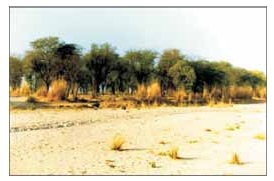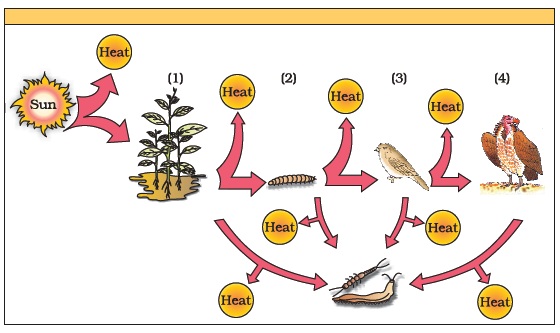Class 12 Important Questions for Biology – Ecosystem
NCERT Exemplar Class 12 Biology is very important resource for students preparing for XII Board Examination. Here we have provided NCERT Exemplar Problems Solutions along with NCERT Exemplar Problems Class 12.
Question from very important topics are covered by NCERT Exemplar Class 12. You also get idea about the type of questions and method to answer in your class 12th examination.
Here you can get Class 12 Important Questions Biology based on NCERT Text book for Class XII. Biology Class 12 Important Questions are very helpful to score high marks in board exams. Here we have covered Important Questions on Ecosystem for Class 12 Biology subject.
Biology Important Questions Class 12 are given below.
Multiple Choice Questions
- Decomposers like fungi and bacteria are:
i. autotrophs
ii. heterotrophs
iii. saprotrophs
iv. chemo-autotrophs. Choose the correct answer:- (a) i and iii,
- (b) i and iv
- (c) ii and iii,
- (d) i and ii
- The process of mineralisation by micro organisms helps in the release of:
- a. inorganic nutrients from humus
- b. both organic and inorganic nutrients from detritus
- c. organic nutrients from humus
- d. inorganic nutrients from detritus and formation of humus.
- Productivity is the rate of production of biomass expressed in terms of:
i. (kcal m–3) yr–1
ii. g–2 yr–1
iii. g–1 yr–1
iv. (kcal m–2) yr–1- (a) ii,
- (b) iii,
- (c) ii and iv,
- (d) i and iii
- An inverted pyramid of biomass can be found in which ecosystem?
- a. Forest
- b. Marine
- c. Grass land
- d. Tundra
- Which of the following is not a producer?
- a. Spirogyra
- b. Agaricus
- c. Volvox
- d. Nostoc
- Which of the following ecosystems is most productive in terms of net primary production?
- a. Deserts
- b. Tropical rain forests
- c. Oceans
- d. Estuaries
- Pyramid of numbers is:
- a. Always upright
- b. Always inverted
- c. Ether upright or inverted
- d. Neither upright nor inverted.
- Approximately how much of the solar energy that falls on the leaves of a plant is converted to chemical energy by photosynthesis?
- a. Less than 1%
- b. 2-10%
- c. 30%
- d. 50%
- Among the following, where do you think the process of decomposition would be the fastest?
- a. Tropical rain forest
- b. Antarctic
- c. Dry arid region
- d. Alpine region
- How much of the net primary productivity of a terrestrial ecosystem is eaten and digested by herbivores?
- a. 1%
- b. 10%
- c. 40%
- d. 90%
- During the process of ecological succession the changes that take place in communities are:
- a. Orderly and sequential
- b. Random
- c. Very quick
- d. Not influenced by the physical environment.
- Climax community is in a state of:
- a. non-equilibrium
- b. equilibrium
- c. disorder
- d. constant change.
- Among the following bio-geo-chemical cycles which one does not have losses due to respiration?
- a. Phosphorus
- b. Nitrogen
- c. Sulphur
- d. All of the above
- The sequence of communities of primary succession in water is:
- a. phytoplankton, sedges, free-floating hydrophytes, rooted hydrophytes, grasses and trees.
- b. phytoplankton, free-floating hydrophytes, rooted hydrophytes, sedges, grasses and trees.
- c. free-floating hydrophytes, sedges, phytoplankton, rooted hydrophytes, grasses and trees.
- d. phytoplankton, rooted submerged hydrophytes, floating hydrophytes, reed swamp, sedges, meadow and trees.
- The reservoir for the gaseous type of bio-geo chemical cycle exists in
- a. stratosphere
- b. atmosphere
- c. ionosphere
- d. lithosphere
- If the carbon atoms fixed by producers already have passed through three species, the trophic level of the last species would be.
- a. scavenger
- b. tertiary producer
- c. tertiary consumer
- d. secondary consumer
- Which of the following type of ecosystem is expected in an area where evaporation exceeds precipitation, and mean annual rainfall is below 100mm
- (a) Grassland
- (b) Shrubby forest
- (c) Desert
- (d) Mangrove
- The zone at the edge of a lake or ocean which is alternatively exposed to air and immersed in water is called:
- a. Pelagic zone
- b. Benthic zone
- c. Lentic one
- d. Littoral zone
- Edaphic factor refers to:
- a. Water
- b. Soil
- c. Relative humidity
- d. Altitude
- 20. Which of the following is an ecosystem service provided by a natural ecosystem?
- a. Cycling of nutrients
- b. Prevention of soil erosion
- c. Pollutant absorption and reduction of the threat of global warming
- d. All of the above
Very Short Answer Type Questions
- Name an organism found as secondary carnivore in an aquatic ecosystem.
- What does the base tier of the ecological pyramid represent?
- Under what conditions would a particular stage in the process of succession revert back to an earlier stage?
- Arrange the following as observed in vertical stratification of a forest: Grass, Shrubby plants, Teak, Amaranths.
- Name an omnivore which occurs in both grazing food chain and the decomposer food chain.
- Justify the pitcher plant as a producer.
- Name any two organisms which can occupy more than one trophic level in an ecosystem.
- In the North East region of India, during the process of jhum cultivation, forests are cleared by burning and left for regrowth after a year of cultivation. How would you explain the regrowth of forest in ecological term?
- Climax stage is achieved quickly in secondary succession as compared to primary succession. Why?
- Among bryophytes, lichens and fern which one is a pioneer species in a xeric succession?
- What is the ultimate source of energy for the ecosystems?
- Is the common edible mushroom an autotroph or a heterotroph?
- Why are oceans least productive?
- Why is the rate of assimilation of energy at the herbivore level called secondary productivity?
- Why are nutrient cycles in nature called biogeochemical cyles?
- Give any two examples of xerarch succession.
- Define self sustainability.
- Given below is a figure of an ecosystem. Answer the following questions.

i. What type of ecosystem is shown in the figure.
ii. Name any plant that is characteristic of such ecosystem. - What is common to earthworm, mushroom, soil mites and dung beetle in an ecosystem.
Short Answer Type Questions
- Organisms at a higher trophic level have less energy available. Comment.
- The number of trophic levels in an ecosystem are limited. Comment.
- Is an aquarium a complete ecosystem?
- What could be the reason for the faster rate of decomposition in the tropics?
- Human activities interfere with carbon cycle. List any two such activities.
- Flow of energy through various trophic levels in an ecosystem is unidirectional and non-cyclic. Explain.
- Apart from plants and animals, microbes form a permanent biotic component in an ecosystem. While plants have been referred to as autotrophs and animals as heterotrophs, what are microbes referred to as? How do the microbes fulfil their energy requirements?
- Poaching of tiger is a burning issue in today’s world. What implication would this activity have on the functioning of the ecosystem of which the tigers are an integral part?
- In relation to energy transfer in ecosystem, explain the statement “10kg of deer’s meat is equivalent to 1 kg of lion’s flesh”.
- Primary productivity varies from ecosystem to ecosystem. Explain?
- Sometimes due to biotic/abiotic factor the climax remain in a particular seral stage (pre climax) without reaching climax. Do you agree with this statement. If yes give a suitable example.
- What is an incomplete ecosystem? Explain with the help of suitable example.
- What are the shortcomings of ecological pyramids in the study of ecosystem?
- How do you distinguish between humification and mineralisation?
- Fill in the trophic levels (1, 2, 3 and 4) in the boxes provided in the figure.

- The rate of decomposition of detritus is affected by the abiotic factors like availability of oxygen, pH of the soil substratum, temperature etc. Discuss.
Long Answer Type Questions
- A farmer harvests his crop and expresses his harvest in three different ways.
a. I have harvested 10 quintals of wheat.
b. I have harvested 10 quintals of wheat today in one acre of land.
c. I have harvested 10 quintals of wheat in one acre of land, 6 months after sowing.
Do the above statements mean one and the same thing. If your answer is yes, give reasons. And if your answer is ‘no’ explain the meaning of each expression. - Justify the following statement in terms of ecosystem dynamics. “Nature tends to increase the gross primary productivity, while man tends to increase the net primary productivity”.
- Which of the following ecosystems will be more productive in terms of primary productivity? Justify your answer. A young forest, a natural old forest, a shallow polluted lake, alpine meadow.
- What are the three types of ecological pyramids. What information is conveyed by each pyramid with regard to structure, function and energy in the ecosystem.
- Write a short note on pyramid of numbers and pyramid of biomass.
- Given below is a list of autotrophs and heterotrophs. With your knowledge about food chain, establish various linkages between the organisms on the principle of ‘eating and being eaten’. What is this inter-linkage established known as? Algae, hydrilla, grasshopper, rat, squirrel, crow, maize plant, deer, rabbit, lizard, wolf, snake, peacock, phytoplankton, crustaceans, whale, tiger, lion, sparrow, duck, crane, cockroach, spider, toad, fish, leopard, elephant, goat, Nymphaea, Spirogyra.
- The energy flow in the ecosystem follows the second law of thermodynamics.” Explain.
- What will happen to an ecosystem if:
a. All producers are removed;
b. All organisms of herbivore level are eliminated; and
c. All top carnivore population is removed - Give two examples of artificial or man made ecosystems. List the salient features by which they differ from natural ecosystems.
- The biodiversity increases when one moves from the pioneer to the climax stage. What could be the explanation?
- What is a biogeochemical cycle. What is the role of the reservoir in a biogeochemical cycle. Give an example of a sedimentary cycle with reservoir located in earth’s crust.
- What will be the P/R ratio of a climax community and a pioneer community. What explanation could you offer for the changes seen in P/R ratio of a pioneer community and the climax community.
| « Previous | Next » |
Answers to Multiple Choice Questions
| 1-c | 2-a | 3-c | 4-b | 5-b | 6-b |
| 7-c | 8-b | 9-a | 10-b | 11-a | 12-b |
| 13-d | 14-d | 15-b | 16-c | 17-c | 18-d |
| 19-b | 20-d |
Class 12 Important Questions for Biology
Biology Important Questions Class 12 are given below chapter wise.
- Reproduction in Organisms
- Sexual Reproduction in Flowering Plants
- Human Reproduction
- Reproductive Health
- Principle of Inheritance and Variation
- Molecular Basis of Inheritance
- Evolution
- Human Health and Diseases
- Strategies for Enhancement in Food Production
- Microbes in Human Welfare
- Biotechnology: Principles and Processes
- Biotechnology and its Applications
- Organisms and Populations
- Ecosystem
- Biodiversity and Conservation
- Environmental Issues
Other Study Material
Go Back to Biology Home Page Physics Chemistry Maths
To get study material, exam alerts and news, join our Whatsapp Channel.


